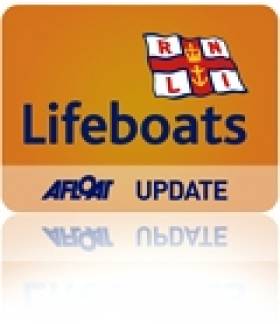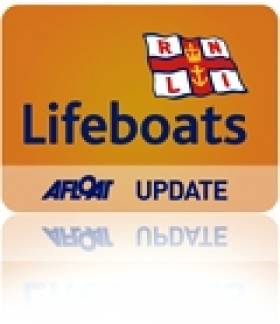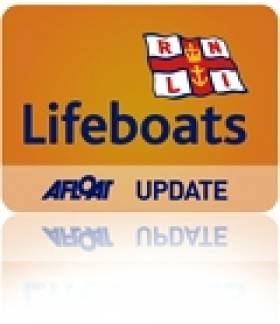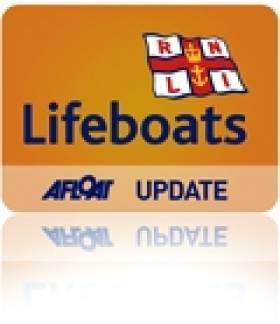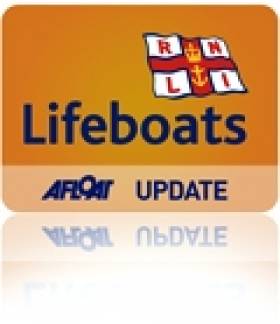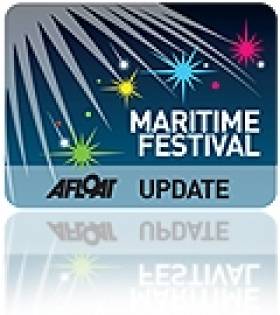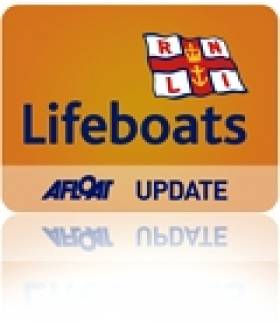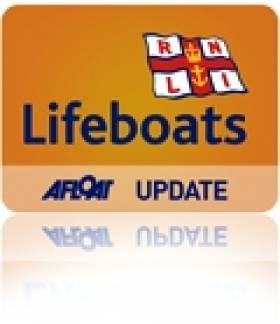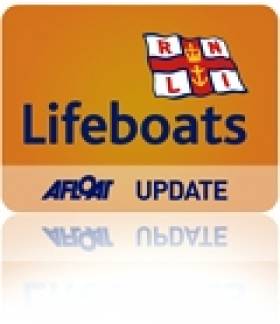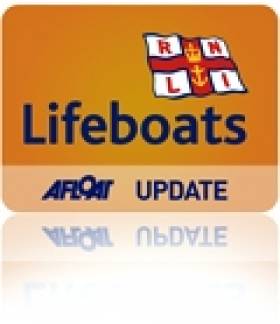Displaying items by tag: RNLI
First Outing for Skerries RNLI's New Lifeboat
#RNLI - Skerries RNLI recorded its first service by its new inshore lifeboat on Sunday afternoon (21 April). SEE VIDEO BELOW
The North Co Dublin lifeboat station's volunteer crew was requested to launch following a report that a vessel was adrift off Bettystown beach.
Crew members, alerted by their pagers, launched their new Atlantic 85 lifeboat Louis Simson within 10 minutes.
It was quickly established that the owner of the vessel was on shore. With the potential for the personal water craft (PWC) to pose a danger, the decision was made to locate it and return it to the beach.
Once on scene, a volunteer crew member was put on board the PWC and brought the vessel safely to shore.
Speaking following the callout, Skerries RNLI volunteer crew member Emma Wilson said: "The visibility was good today, but it was something quite small we were looking for, so being able to have an extra crew member on board our new lifeboat really made a difference during the search."
Video of Joint Exercise on Dublin Bay Depicts Rescue of Boaters
#rnli – A joint exercise held in late March on Dublin Bay between the Dun Laoghaire Coast Guard unit, the Irish Air Corps and the Dun Laoghaire RNLI lifeboats has been documented by Dun Laoghaire lifeboat crew.
The scenario simulates a RIB with four people on board that becomes disabled near Dalkey Island.
Two occupants are suffering from mild hypothermia while two others entered the water and are missing when the operation begins.
#rnli – Lifeboat crew at Rosslare Harbour RNLI in County Wexford had an early morning call out today after they were called to assist two men in difficulty on a yacht.
The request to launch the all-weather lifeboat came at 3.40am following a report that an 8m motor yacht was in trouble two miles north of Tuskar Rock with two people on board.
The two men who requested assistance had been on passage to Dun Laoghaire when they found themselves in difficulty.
The lifeboat crew under coxswain Eamonn O'Rourke were on scene at 4.25am where they assessed the situation and established a tow line.
The weather at the time was described as good with a force two to three wind.
The lifeboat with seven crew members on board proceeded to tow the stricken vessel back to Rosslare Harbour RNLI where it returned at 7.30am.
Speaking following the call out, Dave Maloney, Rosslare Harbour RNLI Deputy Launching Authority said: 'The request for help early this morning required our volunteer crew to leave their beds which they will always willing and selflessly do to help anyone in need. It is thanks to their dedication and commitment that we can launch the lifeboat at all times. Thankfully, the crew on the stricken yacht were not in any immediate danger and we were happy to tow the yacht safely back to shore'.
Busy Saturday for RNLI on Lough Derg
#RNLI - Lough Derg RNLI launched twice yesterday (21 April) on consecutive callouts to a vessel grounded at the Corrakeen Islands and a sinking cruiser at the northern end of the lake.
Around 3.45pm yesterday, Valentia Coast Guard requested the launch of the Lough Derg RNLI lifeboat to assist three people on board their 20ft cruiser after their engine failed and were pushed on to rocks by the Corrakeen Islands in Dromineer Bay.
Helm Eleanor Hooker with Ger Egan and Tom Dunne set out in winds blowing south westerly, force 3 and gusting 5, and the lifeboat was alongside within half an hour of launch.
The two adults and a young child on board were unharmed but extremely anxious. They had dropped anchor to prevent further grounding and breakage.
An RNLI crew member was transferred to their boat to assess for damage and, very quickly - once it was established that the vessel was not holed - set up for a tow, weighed anchor and the lifeboat took them off the rocks and out into safe water.
The lifeboat then towed the boat with her crew (and the RNLI volunteer still on board) to Dromineer Harbour, where RNLI shore crew were waiting to take lines and help.
Lough Derg RNLI crew member Ger Egan advised that said anyone taking their boat afloat after the long winter should "make sure that their engines are fully serviced and make sure to use new fresh fuel".
Later that afternoon the lifeboat launched again to assist two people who had taken to their liferaft as their cruiser was sinking.
The exact location of the 28f cruiser was not certain, but once the lifeboat crew were informed that the cruiser had set out from Terryglass at the northern end of the lake, an half hour earlier they were able to accurately estimate the liferaft’s current location.
At 5.50pm the lifeboat launched with helm Eleanor Hooker, Peter Clake and David Moore on board. Winds were south westerly, force 4, gusting 6.
The lifeboat located the cruiser and the liferaft north of Coolbawn, south of Gortmore, on the eastern shore of Lough Derg, and was alongside by 6.15pm, The two people on board were unharmed, but the skipper was greatly distressed.
He had inadvertently veered off course and had glanced off a rock and holed his boat. A passing 18ft speedboat with two people on board also came alongside and gave assistance.
Two lifeboat crew members helped the people from the liferaft and onto the speedboat, which had a canopy and offered shelter from the wind. They gathered the liferaft and its contents into the cruiser cabin and, as the cruiser was rapidly taking water, they weighed anchor so that the lifeboat could beach the vessel and reduce risk of further damage.
Once beached, the lifeboat crew dropped anchor once more, and especially as the winds were forecast to get up in the night. There was no evidence of fuel leakage and arrangements were made for the vessel to assessed and recovered this morning.
The lifeboat and the speedboat, with the two casualties on board and under cover, then made way to Garrykennedy where friends were waiting to look after them.
Eleanor Hooker thanked Cillian Boyle, the helm of the speedboat, for his kind assistance and commended her crew for their "kind consideration of the casualties and their calm professionalism in dealing with the fraught situation".
Aran Islands RNLI Rescue Fishermen in Galway Bay
#RNLI - Aran Islands RNLI in Galway Bay assisted six fishermen from a 24m trawler yesterday Thursday 18 April.
The volunteer lifeboat crew launched their all-weather lifeboat at 4.20pm following a report that a fishing vessel, the Archangel, with six crew on board had got into difficulty and broken down one mile north west of Inishmore.
There was a six-metre swell at the time with a force seven to eight wind.
The lifeboat crew under coxswain John O’Donnell arrived on scene accompanied in the air by Irish Coast Guard helicopter Rescue 115 - the subject of its own documentary TV series currently showing on RTÉ One - and established a tow line removing the vessel from any immediate danger.
The trawler was then towed back to Rossaveal in Connemara.
Speaking following the call-out, Aran Islands RNLI lifeboat operations manager Michael Hernon said: "Thanks to the speed and efficiency of the crew in launching the lifeboat, we were able to arrive on scene in good time to assist the fishermen and successfully tow the trawler safely to shore."
Lifeboat Prawn Push in aid of Howth RNLI
#lifeboat – As part of the Dublin Bay Prawn Maritime Festival in Howth, North Dublin a Prawn Push in aid of Howth RNLI will take place on Saturday 27th April at 3pm in Howth.
Teams of three wearing maritime themed fancy-dress will take part. One member of the team will push another team-member in a pram or wheelbarrow. The other team-member will have the task of passing around a collection bucket until its weight matches the weight of a kilo of prawns.
The route will start at the Top House Pub in Howth village, via Church Street to Findlater's Pub and back to the children's playground near the east Pier. Rehydration stations will be set up along the route where competitors will have to down a drink as fast as they can. Prizes awarded will include winners of the race and best fancy-dress. Prize-giving will take place at the Festival Marquee immediately after the race.
Teams can be from pubs, clubs or groups. All participants must be over 16 years of age. Teams must supply their own prams or wheelbarrows. Entries and enquiries can be made to Eddie Caffrey on 086 832 0786 or by email to [email protected] .
'Funds raised by the Lifeboat Prawn Push will ensure that our volunteer lifeboat crews go to sea with the best equipment available to ensure their safety when saving lives at sea' said Rose Michael, Howth RNLI Fundraising Chairperson.
Douglas RNLI Brings Shannon Class To Irish Sea
#RNLI - The Irish Sea will soon have one of the most advanced lifeboats in service as Douglas RNLI in the Isle of Man has been earmarked to receive one of the new Shannon class.
The new design is 50% faster than the lifeboat it will replace, ensuring that those in need are reached even faster.
The RNLI plans to replace the Tyne class lifeboat at Douglas in 2016, which is reaching the end of its planned 25-year life span. The new lifeboat will cost £2 million (€2.32 million) and the RNLI is currently working to identify whether the funding for the new lifeboat can be raised from legacy gifts or whether fundraising activity is needed. The RNLI will announce this once the funding strategy has been identified.
The Shannon is the first modern RNLI all-weather lifeboat to operate with water jets, not propellers. Capable of 25 knots, the Shannon is 50% faster than the classes it has been designed to replace, which have a lower maximum speed of 17 knots.
The Shannon class will also improve safety for the charity’s volunteer crews, thanks to its shock absorbing seats and on-board computer system, which allows the crews to operate and monitor the lifeboat from the safety of their seats.
Michael Vlasto, RNLI operations director said of the new vessel: "I have had the privilege of being involved with the RNLI for over 38 years. In that time I have witnessed great advances in the charity’s lifeboats and seen many new vessels arrive on station. However, I have never seen our volunteer crews quite as excited as they are about the Shannon.
"This all-weather lifeboat is half as fast again as the lifeboats it has been designed to replace and using water jet propulsion, the manoeuvrability is exceptional. Most importantly though, the Shannon has been carefully developed with the safety of the volunteer crews at the very heart of the design, allowing them to shave life-saving moments off the time it takes to reach those in trouble at sea."
Some of the RNLI Douglas volunteer crew were given the opportunity to experience the Shannon first-hand with a trip around Douglas Bay last weekend as the prototype lifeboat visited the island as part of sea trials that began in January, as previously reported on Afloat.ie.
Afterwards, Douglas coxswain Neal Corran was asked for his immediate thoughts on the new lifeboat. "I was impressed with the boat’s speed and manoeuvrability and look forward to Douglas receiving theirs when it becomes available," he said.
The Shannon has been developed by the RNLI’s in-house team of naval architects, marine engineers and operators - including Irish naval architect Peter Eyre – to replace the majority of Mersey and some remaining Tyne class lifeboats as they reach the end of their operational life (subject to the RNLI’s five-year rolling review of lifesaving assets).
Once the Shannon is rolled out across the UK and Ireland, this class of lifeboat will make up a third of the RNLI all-weather lifeboat fleet, at which point the RNLI will have reached its aim of a 25 knot all-weather lifeboat fleet.
The majority of the 50-plus Shannon class lifeboats to be stationed throughout the UK and Ireland will be built at the RNLI’s new all-weather Lifeboat Centre in Poole, which is currently under construction. Bringing all-weather lifeboat production in-house will save the charity £3.7m annually – the equivalent of 2.5 Shannon class lifeboats.
RNLI Crews Assist Windsurfer, Stricken Fishing Boat in Co Down
#RNLI - Portaferry RNLI rescued a windsurfer who got into difficulty off the Co Down coast yesterday (16 April).
The volunteer crew launched their inshore lifeboat before 5pm yesterday evening to go the aid of the injured windsurfer reported to be in the area of Pig Island, a small island in Strangford Lough close to Newtownards Sailing Club.
The weather at the time was described as blowing slight to moderate winds with good visibility.
The crew was on scene at 5.15pm where they found the man on Pig Island accompanied by two other men. The windsurfer, who was suffering from a shoulder injury, was transferred to the lifeboat and made comfortable before being taken to the sailing club, where he was then transferred into the care of the coastguard and passed to the ambulance service to be taken to hospital.
Speaking after the rescue, Portaferry RNLI lifeboat operations manager Brian Bailie said: "As the charity that saves lives at sea, we will always respond to any call for help where someone is in danger.
"Strangford Lough is a popular destination for a wide range of water sport enthusiasts and it is important that they take all necessary precautions when using the lough.
"As we are all aware, accidents can and do happen and it is at such times that the work carried out by the volunteer crews of the RNLI is so important."
Elsewhere in Co Down yesterday, Bangor and Donaghadee RNLI assisted a fisherman whose 28ft commercial fishing boat experienced engine failure.
The crew quickly located the disabled boat one mile west of the Copeland Islands at the mouth of Belfast Lough yesterday morning after 11.15am.
With the vessel drifting closer to the island shores and the wind gusting gale force eight, a tow line was quickly rigged and passed to the fishing boat. Bangor RNLI was escorted by Donaghadee RNLI's all-weather lifeboat as it towed the fishing vessel to the safety of Bangor Harbour.
Bangor RNLI volunteer helm Peter Scott, who was involved in this rescue, said: "Engine failure close to shore could lead to a life threatening situation. We always urge everyone going to sea to make sure their electrical systems and engine are well maintained and in good working order. A good anchor and chain should always be carried as part of essential safety equipment.
"We are glad the skipper of this vessel is now safely ashore," he added.
Speedboat on Rocks Leads to Lough Derg Lifeboat Rescue
#lifeboat – At 17.40hrs this evening Valentia Coast Guard requested Lough Derg Lifeboat to launch to assist three people on board their 18ft speedboat, after they lost steerage and were pushed on to rocks by the entrance to the Scarriff River in Scarriff Bay, at the south western end of Lough Derg.
The lifeboat launched at 17.50hrs with Helm Ger Egan, David Moore and Tom Dunne on board. Winds were south westerly, Force 6, gusting 7. The lifeboat was alongside at 18.13hrs. The three people on board were calm, safe and unharmed. An RNLI crew member was transferred to their boat to assess for damage. When it was established that the vessel was not holed, it was taken off the rocks and towed out into safe water. The lifeboat then towed the boat with her crew, and an RNLI volunteer still on board, back up the Scarriff River to her berth.
Lough Derg RNLI Helm Ger Egan, said that before going afloat at the beginning of the season, boat users should 'check that their boat is in full working order and also consider the weather forecast'.
The Lifeboat returned to station and was ready for service again at 19.10hrs.
Clifden RNLI To Trial New All-Weather Lifeboat
#RNLI - The RNLI has announced that Clifden lifeboat station in Co Galway is to receive an all-weather class lifeboat for a trial period of 12 months to operate in conjunction with the existing inshore lifeboat service.
The decision, which will see the volunteer crew take delivery of a carriage-launched Mersey class lifeboat, was made this week when the charity’s trustees accepted the recommendation of its operations committee. It follows an in-depth review of lifeboat cover in the area.
The RNLI carries out a five-yearly review of lifeboat stations, looking at the incidents they launch to and the changing pattern of marine activities to ensure the existing and future lifeboat coverage is appropriate.
All-weather lifeboats can be operated safely in all weather conditions while inshore lifeboats usually operate closer to shore, in shallower water, close to cliffs, among rocks or even in caves.
Introduced as the RNLI’s first fast-carriage lifeboat, the Mersey class has a top speed of 17 knots. Designed to operate from a carriage, slipway or lie afloat, this class of lifeboat is also capable of being self-righted in challenging conditions.
The Mersey - which can carry a lifeboat crew of six - also carries an X boat, a small unpowered and manually launched inflatable daughter boat to allow the crew to access areas where the lifeboat cannot reach.
Last year, Clifden RNLI launched eight times bringing seven people to safety. Of those launches, two services were in the dark. In all, some 82 service hours were spent at sea.
A lifeboat station was established in Clifden in early 1988 and the station currently operates two inshore lifeboats.
Clifden RNLI lifeboat operations manager John Brittain said the crew were "delighted" at the decision to trial the new lifeboat in the Galway town.
"The new boat will allow us to provide lifesaving cover in all weathers up to 100 miles off the Connemara coast," he said. |This is a significant investment by the RNLI and we are excited to be trialling a Mersey class lifeboat."
RNLI divisional operations manager Owen Medland added: "Our charity’s priority is to save lives at sea and by conducting regular reviews of lifeboat cover around our coastline, we can ensure we provide the best possible search and rescue service.
"After careful scrutiny, the RNLI feels that an all-weather lifeboat may be suited to the service launches that Clifden volunteers get tasked to. The co-location of the new lifeboat for a trial period of 12 months will allow us to assess the long-term value for this type of lifeboat while ensuring that any change at Clifden means the right type, balance and capability of the lifeboats are operating in this location to respond to emergencies."
The timescale for the arrival of the all-weather lifeboat has yet to be confirmed but will coincide with the training of the volunteer lifeboat crew to meet the demands of the new vessel.


























